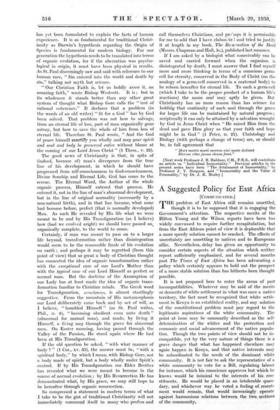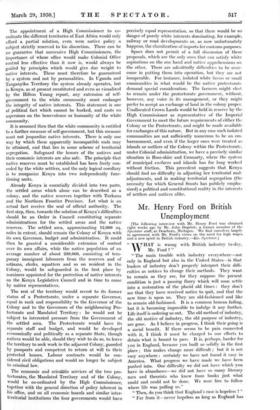A Suggested Policy for East Africa
[COMMUNICATED.]
THE problem of East Africa still remains unsettled, though it is to 'be supposed that it is engaging the Government's attention. The respective merits of the Hilton Young and the Wilson reports have been too widely canvassed to require further recapitulation, but from the East African point of view it is deplorable that a more speedy solution cannot be reached. 'The effects of uncertainty are unsettling to natives and to Europeans alike. Nevertheless, delay has given an opportunity to consider certain aspects of the situation which neither report sufficiently emphasized, and for several months past The Times of East Africa has been 'advocating a policy which certainly appears to hold out the prospect of a more stable solution than has hitherto been thought possible.
It is not proposed here to enter the arena of past incompatibilities. Whatever may be said of the merits or demerits of white settlement in what was once' a native territory, the fact must be recognized that white settle- ment in Kenya is an established reality, and any solution of the constitutional problem must pay regard to the legitimate aspirations of the white community. The' point at issue may be summarily described- as the self- determination of the whites and the protection and economic and social advancement of the native popula- tion. Though the two points of view should not be 'in- compatible, yet by the very nature of things there is a grave danger that what has happened elsewhere may again happen in Kenya, and that native interests may be subordinated to the needs of the dominant white community. It is not fair to ask the representative of a white community to vote for a Bill, regulating labour for instance, which his conscience approves but which he knows would be inimical to the interests of his-; con- stituents. He would be placed in an intolerable quan- dary, and whichever way he voted a feeling of resent- ment would remain, that would increasingly operate against harmonious relations between the two sections of the community. The appointment of a High Commissioner to co- ordinate the different territories of East Africa would only afford a partial solution, even were native policy a subject strictly reserved to his discretion. There can be no guarantee that successive High Commissioners, the importance of whose office would make Colonial Office control less effective than it now is, would always be guided by principles which would give due weight to native interests. These must therefore be guaranteed by a system and not by personalities.. In Uganda and Tanganyika Territory the system already operates, but in Kenya, as at present constituted and even as visualized by the Hilton Young report, any extension of self- government to the white community must endanger the integrity of native interests. This statement is one of political fact which cannot be burked, and casts no aspersions on the benevolence or humanity of the white community.
It is assumed then that the white community is entitled to a further measure of self-government, but this measure must not jeopardize native interests. There is only one way by which these apparently incompatible ends may be attained, and that lies in some scheme of territorial segregation. Safeguard the homes of the natives and their economic interests are also safe. The principle that native reserves must be established has been freely con. ceded by the white settlers, and the only logical corollary is to reorganize Kenya into two independently func- tioning units.
Already Kenya is essentially divided into two parts, the settled areas which alone can be described as a colony, and the native reserves together with Turkana and the Northern Frontier Province. Let what is an actual fact receive the seal of official authority. The first step, then, towards the solution of Kenya's difficulties should be an Order in Council constituting separate administrations, for the settled areas and the native reserves. The settled area, approximating 12,000 sq. miles in extent, should remain the Colony. of Kenya with its own. Governor, budget and administration. It could then be granted a considerable extension of control over its own affairs, while the native population of an average number of about 230,000, consisting of tem- porary irmnigrant labourers from the reserves and of artisans, clerks, squatters and so on resident in the Colony, would be safeguarded in the first place by nominees appointed for the protection of native interests on the Kenya Legislative Council and in time to come by native representatives.
The rest of the territory would revert to its former status of a Protectorate, under a separate Governor, equal in rank and responsibility to the Governor of the Colony and to the Governors of the neighbouring Pro- tectorate and Mandated Territory : he would not be subject to interested pressure from the Government of the settled area. The Protectorate would have its separate staff and budget, and would be developed economically and politically as a separate State, though natives would be able, should they wish to do so, to leave the territory to seek work in the adjacent Colony, guarded by passports and competent to return at will to their protected homes. Labour contracts would be con- sidered civil obligations and would no longer be subject to criminal law.
The economic and scientific services of the two pro- tectorates, the Mandated Territory and of the Colony, would be co-ordinated by the High Commissioner, together with the general direction of policy inherent in his office, and on all economic boards and similar inter- territorial 'institutions' the four governments would • have precisely equal representation, so that there would be no danger of purely white interests dominating, for example, railway or road developments or, as now unfortunately happens, the classification of imports for customs purposes.
Space does not permit of a full discussion of these proposals, which are the only ones that can satisfy white aspirations on the one hand and native apprehensions on the other. There are admittedly difficulties to be over- come in putting them into operation, but they are not insuperable. For instance, isolated white farms or small communities in what would be the native protectorate demand special consideration. The farmers might elect to remain under the protectorate government, without, however, any voice in its management, or they might prefer to accept an exchange of land in the colony proper. Unallocated Crown Lands would be held in reserve by the High Commissioner as representative of the Imperial Government to meet the future requirements of either the Colony or the Protectorate, and might be made available for exchanges of this nature. But in any case such isolated communities are not sufficiently numerous to be an em- barrassment, and even if the larger ones were treated as islands or outliers of the Colony within the Protectorate, under Colonial administration, we have a precisely similar situation in Ross-shire and Cromarty, where the system of municipal enclaves and islands has for long worked without friction. This precedent suggests that Kenya should find no difficulty in adjusting her territorial mal- adjustments, and in making territorial segregation (the necessity for which General Smuts has publicly empha- sized) a political and constitutional reality in the interests of settlers and natives alike.















































 Previous page
Previous page